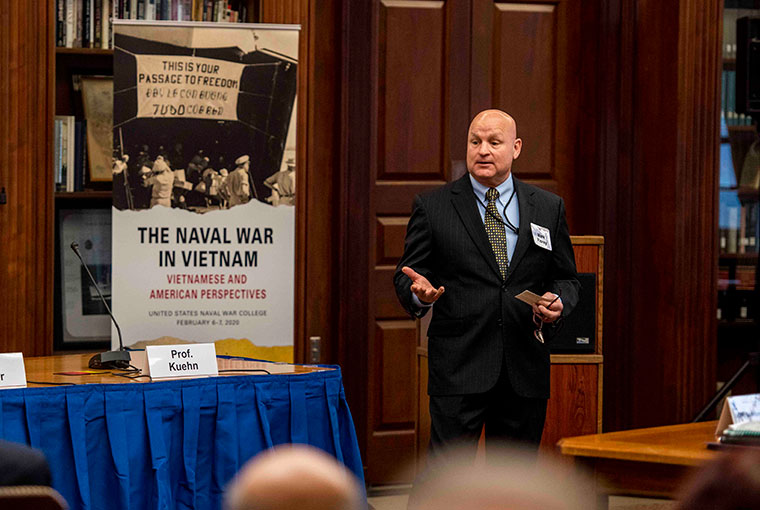Conference on Naval War in Vietnam Includes American, Vietnamese Perspectives

The U.S. Naval War College gathered military scholars and historians from the American and Vietnamese perspectives for a Feb. 6-7 conference examining the role of naval power in the Vietnam conflict.
The conference looked at the Vietnam War as an example of a “limited war” in the shadow of the Cold War – a topic of renewed interest in today’s climate of escalating great-power competition.
“During times of peace, that’s when we have the space to reflect and solidify the wartime lessons,” said Rear Adm. Shoshana S. Chatfield, Naval War College president, during her welcome remarks to the group.
“As you look at particular cases and consequences of one of the longest wars in American history, I know that you will discuss the importance of successfully navigating the difficult mechanisms of war termination,” she said.
“Looking at it from both the American and Vietnamese perspectives, I think we can all agree that if we collectively do not get war termination right, those times of interwar peace are doomed to become shorter and shorter.”
Conference organizer Mark Fiorey, deputy director of the college’s Hattendorf Historical Center, said he has been interested in the Vietnam War since childhood.
Later, as a Navy veteran and student of history, Fiorey came across a letter from a 1960 Naval War College graduate who led the South Vietnamese navy at the war’s end. The man’s story gripped him, adding more fuel to Fiorey’s scholarly interest in the conflict.
Soon Fiorey was doing oral history interviews in Northern California with South Vietnamese veterans of the war. He discovered San Jose’s Museum of the Boat People & the Republic of Vietnam.
“I wanted to put together a conference on the naval war. Often Americans tend to think of the Vietnam War as a land war – the Army and Marines. But the Navy played a huge, huge role,” Fiorey told the gathered scholars on Feb. 6.
“And today we’re going to hear things we’ve never heard before. I wanted to go down that road because I hadn’t seen a conference on Vietnam where you had Vietnamese and American perspectives,” he said.
Nha Duc Hoang, a former minister in the South Vietnamese government, spoke about the 1974 naval battle in which China seized control of the Paracel Islands from Vietnam.
Hoang, who immigrated to the United States in 1975, suggested that the 1974 battle was a precursor to China’s current aggressive behavior in the South China Sea, where it is asserting ownership of land and sea rights.
“I want to talk about how South Vietnam and North Vietnam dealt with China. Both sides lost, and as a result, China is trying to establish its dominance over this particular part of the world,” Hoang said.
Even though Hanoi reaffirmed its sovereignty over the Paracel and Spratly archipelagoes in the South China Sea in 1979, he said, the battle had already been lost and China employed a slow encroachment campaign.
“The Chinese couldn’t do much in the northern Pacific, so they wanted to treat the South China Sea as ‘mare nostrum,’ like the Romans would consider the Mediterranean in the old days,” Hoang said.
“So, they used tactics they first launched in the Paracel Islands battle – fishing trawlers first, Coast Guard and then main naval assets in the background. As you read now, that’s the tactics China is currently using,” he said.
Speakers discussed the use of U.S. naval ships to evacuate refugees at several points during the long war.
Operation Passage to Freedom from 1954-55 transported 310,000 Vietnamese fleeing North Vietnam after the French defeat in the first Indo-China War. At war’s end, Operation Frequent Wind featured U.S. aircraft and ships in a frantic effort to save U.S. and South Vietnamese citizens as Saigon fell in April 1975.
Other scholars discussed how the Vietnam war changed the way the U.S. Navy operates in the air, on land, in riverine units and in mine countermeasures.
For example, the Navy in 1969 created “Top Gun,” the Navy Fighter Weapons School, to improve the performance of fighter pilots following disappointing results against the technologically inferior MiG fighters over Vietnam.
Fiorey said he hopes to collect the papers presented at the conference in a future book.
The oldest institution of its kind in the world, the U.S. Naval War College offers graduate education to military officers and national security professionals and is accredited to award the Master of Arts degree. The college serves roughly 600 in-residence graduate students and more than 1,000 distance-education students each year.
